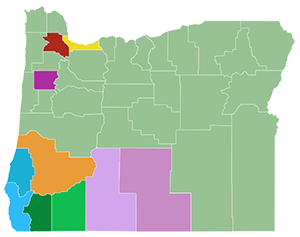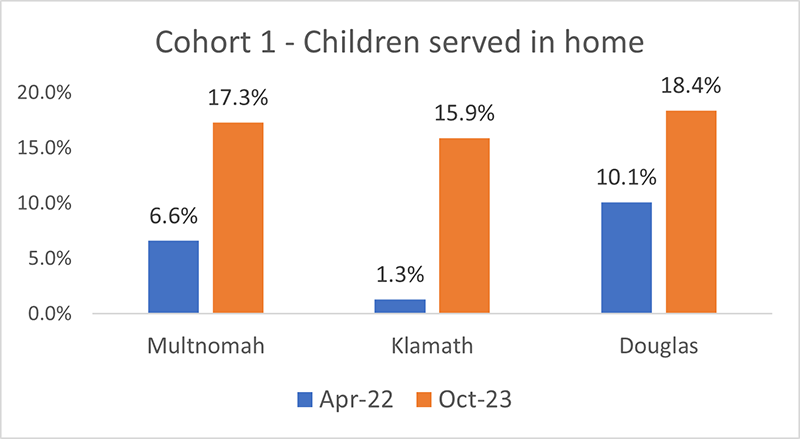Keeping families together, stable and safe
Family Preservation is a collaborative approach to serving families in their homes and communities, instead of foster care. Right now, we're testing this approach in locations across Oregon. Child Welfare, Self-Sufficiency Programs, Tribes and communities work together as a strong team to help families get what they need, when they need it. This could be economic support, family coaching, connection to local resources or other tailored services.
LocationsUpdatesFAQPartner resourcesFamily First ActDoris Duke Foundation grant Contact us
Our goals for supporting families
Family Preservation is central to our agency's effort to
build well-being for all people and families in Oregon. The needs of the whole family are crucial to this work. With stability comes safety – not the other way around. By working together with internal and external partners, we can identify needs earlier and provide resources that prevent intensive child welfare involvement. This work is a continuation of our vision to transform Child Welfare and Self-Sufficiency Programs.
We are committed to the following goals in partnership with families and communities:
- Increasing families' access to supports before child welfare interventions
- Serving and supporting children and families together in their homes and communities, rather than separating them
- Stabilizing families by meeting concrete needs and supporting connections to community and family
- Achieving positive outcomes for all families, particularly families of color
Demonstration sites
Oregon is using a phased approach to implement and evaluate Family Preservation in Oregon. This helps us understand what works best and quickly make adjustments if needed before we implement changes statewide. We are working with a diverse group of families, people with lived experience, community partners and service providers to co-design the Family Preservation approach.
Current locations

We're testing the Family Preservation approach in these districts:
- District 2 - Alberta and Gresham branches in Multnomah County
- District 3 - Polk County
- District 6 - Douglas County
- District 7 - Coos and Curry Counties
- District 8 - Jackson and Josephine Counties
- District 11 - Klamath County
- District 16 - Washington County
View map
Updates
Through our demonstration sites, we have identified four
Foundational Elements that are needed to achieve the goals of Family Preservation. Read about what we're learning related to each Foundational Element.
Intra-agency Relationships
Intra-agency relationships are key.
- A strong collaborative relationship between Self-Sufficiency Programs (SSP) and Child Welfare (CW) is essential to providing complete supports to families in their homes.
- The needs of the whole family are crucial to this work. With stability comes safety – not the other way around.
- By working together, we can identify needs earlier and provide resources that prevent intensive CW involvement.
Community Engagement
Community is our greatest asset for keeping families together and stable.
- Communities already have the wisdom and assets to provide safe, stable and healthy lives for children, adults and families.
- Our role is to share, grow and redistribute resources to our community.
- Community engagement can be uncomfortable. For CW it may mean hearing how the agency has harmed individuals, families and communities. For SSP it may mean sitting with folks as they talk about the barriers and inequities related to accessing needed benefits and supports. Listening is how we earn trust and move to shared solutions.
Practice
Questioning our practice helps us make progress toward our vision.
- In the demonstration sites we are consistently questioning our practice, each other, and the system in which we work.
- For change to occur, we must ask tough questions, such as why most families we serve in their homes in the demonstration sites are white, while families of color continue to be separated.
- In our practice we must continue to ask, do we serve and support the whole family? In CW do we fully understand safety threshold and in-home criteria? In both programs do we share responsibility for tasks, outcomes, and progress with families?
Support and Services
Trusted relationships make supports and services work.
- Services don't create safety; networks of support do. Services can build knowledge and networks.
- Listen and understand what families need, then support those resources. Each community is different.
- Make sure the services and supports are meeting the cultural and linguistic needs of the community.
More families are being served in home
What is the measure?
One of the long term goals of the Family Preservation approach is for ODHS to equitably serve more children and families in their homes and communities.
We are looking at the percentage of Child Welfare cases that are opened where families are being served together in their homes with an in-home safety plan, along with the percentage of cases where families are separated for foster care.
The goal over time is to see the percentage of families served together in their homes outpace the use of foster care.

Why it's important
Foster care is traumatic for children, parents and communities for generations. Research and data demonstrates that children and families do better in the short and long term when they remain together while addressing changes needed for safety and stability.
What we are doing
The Family Preservation Demonstration Cohort 1 (Klamath County, Douglas County, Multnomah County/Alberta Branch) has been hard at work to achieve the goal of serving more children and families in-home by engaging with their communities, listening to families and trying new and innovative approaches to meeting the expressed needs of communities and families.
We want to share what we're learning about how to best support families so they can stay together, stable and safe. Your feedback and input are valuable, and we will reach out as we continue to learn, grow and transform how we support families through this effort.
Please email us if you have questions or want to get involved.
Partner resources